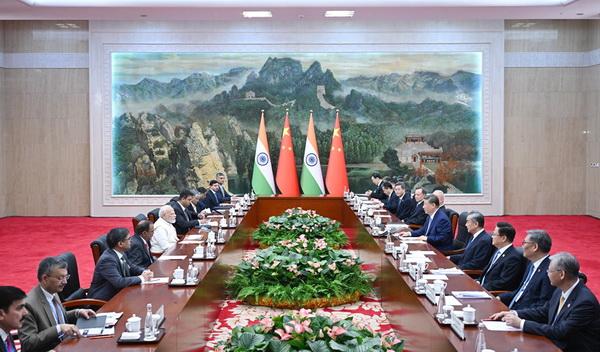Eric's Insight: How long will India's zest for China last?
Indian Prime Minister Narendra Modi attended the Shanghai Cooperation Organization (SCO) Summit in Tianjin from August 30 to September 1, marking his first visit to China in seven years.
China and India are the two most populous countries in the world and key members of the Global South, and Modi’s visit to China has drawn global attention. So how much enthusiasm does India have for improving its relations with China?

Chinese President Xi Jinping meets with Indian Prime Minister Narendra Modi in Tianjin, north China, Aug. 31, 2025. Photo/Chinese Foreign Ministry
Restart and warm-up after a low
On August 31, Chinese President Xi Jinping met with Indian Prime Minister Narendra Modi at the Tianjin Guest House. Subsequently, Cai Qi, Member of the Standing Committee of the Political Bureau of the CPC Central Committee and Member of the Secretariat of the CPC Central Committee, also held a separate meeting with Modi. This highlights the gradual restart of China-India relations.
Amid the turbulent international landscape over the past five years, China-India relations have undergone changes and hit a post-Cold War low.
In October 2024, the leaders of the two countries held a meeting in Kazan, Russia, marking the slow recovery of bilateral ties. The arrival of Trump’s second term in 2025 prompted India to once again exhibit obvious "strategic swings," creating an opportunity for the improvement and development of China-India relations.
Modi’s visit to Tianjin, China, underscores India’s attempt to break free from its past strategic framework.
Over the past years, India has prioritized Prime Minister Modi’s participation in the G7 and G20 summits, while neglecting its involvement in the BRICS or SCO. In fact, India has even played a sort of passive role in these two cooperative mechanisms.
During the meeting between the leaders of China and India, the Indian side reaffirmed that the two countries are development partners rather than rivals, with consensus far outweighing disagreement. Modi said India is ready to view and develop bilateral ties from a long-term perspective, adding both countries pursue strategic autonomy and an independent foreign policy, and their bilateral relationship is not subject to the influence of any third party.
Calmly addressing differences, disagreements
However, India’s efforts to improve its relations with China remain "tentative." Strictly speaking, Modi’s visit this time was for the SCO leaders’ summit rather than a state visit to China.
It should be noted that before arriving in Tianjin, the Indian Prime Minister specially visited Japan as a strategic hedge.
Additionally, Modi is one of the few SCO summit leaders who will not attend the September 3 commemorative event in Beijing marking the 80th anniversary of the victory in the Chinese People’s War of Resistance Against Japanese Aggression and the World Anti-Fascist War. This indirectly reflects the China-India difference in perspectives on history and views on international order.
The restoration and development of China-India relations face even greater challenges from the struggles among different political factions within India.
Due to years of anti-China and pro-U.S. propaganda, as well as the strategic direction of the Indian government, pro-American factions still dominate the major Indian platforms for public opinion and policy making. This makes it rather difficult to reverse the entrenched perceptions and ideological preferences.
Furthermore, the deep-seated distrust of China persists among certain forces within India. Even if Prime Minister Modi himself attempts to pursue a balanced policy toward China, his preferences may not be effectively translated into actual policies of the Indian government.
Without concrete adjustments in India’s approach toward China, the improvement in bilateral relations may still amount to "much thunder but little rain."
An even more important factor is, of course, how the tariff war between India and the United States will evolve.
Although the India-U.S. tariff war appears intense, there remains the possibility for the two sides to reach an agreement shortly. Once U.S.-India relations is restored to calm, how long will India’s enthusiasm for improving ties with China last? Clearly, this is still unknown.
Source: Mekong News Network; Writing by Lin Minwang; Trans-editing by Wang Shixue
(The writer is a professor and vice dean of the Institute of International Studies, Fudan University)